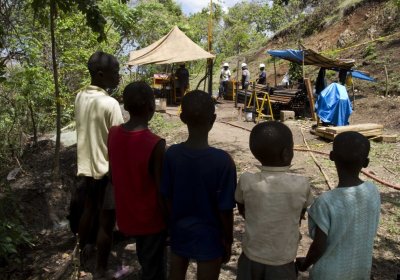A small but vocal group of people gathered outside the Land and Environment Court in Sydney on August 20 to protest against Rio Tinto’s plans to extend its Mount Thorley Warkworth coalmine near Bulga, in Singleton Shire in the NSW Hunter Valley.
The protesters held banners saying “Don’t bugger Bulga”, “Stop coal and gas destroying NSW” and “Save the Warkworth Sands Woodlands”, while they chanted slogans such as “Rack off Rio Tinto.”
Mining
OK, nobody panic or anything, but it seems another key plank in Gina Rinehart's plot to destroy the Earth has been given the green light. Gina Rinehart's multibillion-dollar Alpha coal mine and rail project in central Queensland has been granted federal government approval, ABC.net.au said on August 23.
The Fullerton Cove Residents Action Group released the statement below on August 20.
* * *
Residents of Fullerton Cove, on the outskirts of Newcastle, have set up a blockade this morning to prevent Dart Energy from drilling two coal seam gas pilot production wells, which are currently under construction.
Three open cut coalmines have been proposed over the Leard State Forest and adjoining farmland near Boggabri in NSW. Two mines currently operate in the forest, but their proposed expansion and a brand new mine would clear 50% of the forest.
The National Parks Association of NSW says the forest is “home to 26 threatened plant and animal species” and is “the single biggest remnant of native vegetation left on the heavily cleared Liverpool Plains”.
Two new mines are being assessed within the Tarkine rainforest in north-west Tasmania. The Tarkine is well known for the public battles to save it from logging, and was given emergency National Heritage listing in 2009.
But that status lapsed in December 2010, and with the global price of minerals rising, mining companies began to explore the area. Ten mines have been proposed for the area — nine of them open cut. The first two mines planned will produce tin and iron ore.
Anglesea Air Action, a group of residents opposed to the Victorian government’s plan to extend the lease for Alcoa’s Anglesea coalmine for 50 years, released the statement below on August 15.
* * *
Anglesea Air Action criticise the state government’s renewal and extension of the Anglesea coalmine without releasing the Alcoa Health Risk Assessment which, it has been revealed, have been on their files for years.
The story behind the corporation that owns the Beverley uranium mine in north-east South Australia is scarcely believable.
Heathgate Resources — a 100%-owned subsidiary of General Atomics (GA) — owns and operates Beverley and has a stake in the adjacent Beverley Four Mile mine. Over the years, GA CEO Neal Blue has had commercial interests in oil, Predator drones, uranium mining, nuclear reactors, cocoa, bananas and real estate.
People and governments across Latin America are rising up against foreign mining companies in a wave of revolt generating alarm among investors and their political operatives in the imperialist governments.
In Haiti, United States and Canadian gold mining companies are rubbing their hands over the riches that they believe await them. A recent study by Haiti Grassroots Watch estimates up to US$20 billion, at gold’s current price of $1600 an ounce, lies in the ground.
Bolivian President Evo Morales applauded on July 10 the agreement struck with indigenous peoples from the mining town of Mallku Khota, in the north of Potosi, to nationalise a Canadian-owned mining company.
Morales said the agreement ensures the state can continue recuperating natural resources to benefit the Bolivian people.
The head of state met with leaders from the ayllus (indigenous communities) in this region that were demanding the concession granting to the Canadian company South American Silver (SAS) be annulled.
In the space of a decade, Australia’s mining sector has come to dominate the country’s economic life. In June, Reserve Bank governor Glenn Stevens said mining investment is tipped to “be about as large as business investment in the rest of the private economy combined” by mid 2014.
Adopting a centre-left reforming image, Peruvian President Ollanta Humala was narrowly elected last year on the back of widespread discontent with destructive neoliberal development policies and a widening wealth gap.
His supporters were filled with the hope that real and substantive change was imminent. Other progressives welcomed the Humala victory more cautiously, arguing that it was at least the lesser of two evils. The alternative was ultra right-winger Keiko Fujimori.
The Environmental Defender’s Office NSW has advised community group Illawarra Residents for Responsible Mining Inc in a court case that will test the legality of mining company Gujarat NRE’s decision to start longwall mining in its Russell Vale colliery earlier this year.
- Previous page
- Page 31
- Next page










